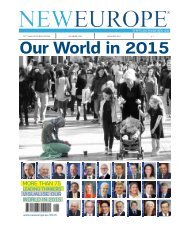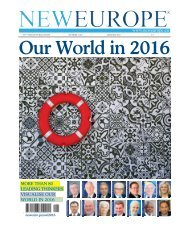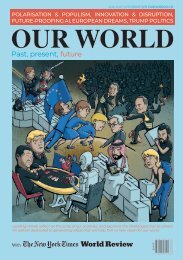Our World in 2018
Leading minds reflect on the state of our societies, and examine the challenges that lie ahead. An edition dedicated to generating ideas that will help form a new vision for our world.
Leading minds reflect on the state of our societies, and examine the challenges that lie ahead. An edition dedicated to generating ideas that will help form a new vision for our world.
You also want an ePaper? Increase the reach of your titles
YUMPU automatically turns print PDFs into web optimized ePapers that Google loves.
OUR ECONOMIES
Short-Term
Gains,
Long-Term
Hazards
By Maurice Obstfeld
AN
the state-mint in Rome, Italy.
EPA
The year 2017 appears to be ending
on a high note, with GDP growth in
much of the world continuing to rise,
marking the broadest cyclical upswing since
the start of the decade. Throughout Europe
and Asia, and in the United States and Canada,
growth expectations have risen, while some
important emerging economies that until
recently were shrinking – for example, Brazil
and Russia – have resumed growth.
Several countries continue to struggle,
including many fuel exporters and low-
or natural disasters, especially drought. But
faster recovery is benefiting roughly twothirds
of the world’s population.
These developments follow years of
geographically uneven, stop-and-go growth
following the global crisis of 2008-2009 and
the subsequent 2010-2011 rebound. As
recently as early 2016, the world economy
sputtered, driving the price of oil to near $25
per barrel (it is now around $60) and yielding
the weakest global growth rate since the
outright contraction of 2009. Thus, heading
into 2018, the sense of relief among many
economic policymakers is palpable.
Why has economic performance
improved? While there has been a marked
rise in indicators of consumer and business
sentiment, and with them, investment, it
would be wrong to attribute the recent
upswing entirely to happenstance or “animal
spirits.” Fundamental factors, notably
Maurice
Obstfeld
Maurice Obstfeld
is Chief Economist
of the International
Monetary Fund.
macroeconomic policies, have been at work
as well.
Monetary policy has long been and
remains accommodative in the largest
countries. Even though the United States
Federal Reserve continues to raise interest
rates gradually, it has been cautious, having
wisely responded to the turbulence of early
2016 by postponing previously expected
rate increases. The European Central Bank
has started to taper its large-scale asset
purchases, but has also signaled that interestrate
increases are a distant prospect.
As a result, financial conditions have
been easy, buoying both lending and asset
prices worldwide. Fiscal policy in advanced
economies has, on balance, shifted from
contractionary to roughly neutral over the
past few years, while China has provided
slowed at mid-decade, with important
positive spillovers to its trade partners.
remain relatively low – indeed, puzzlingly so
in the advanced economies – even as gaps
between actual and potential GDP have
narrowed or closed. Some might view the
of all possible worlds.
For many countries, however, longer-term
growth prospects are less encouraging. Aging
workforces, slower productivity growth, and
higher debt burdens since the crisis darken
56 2018 | OUR WORLD










